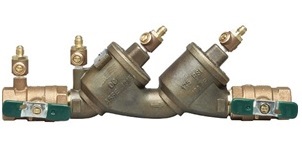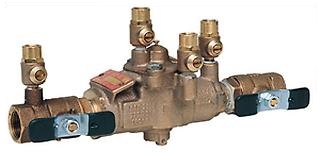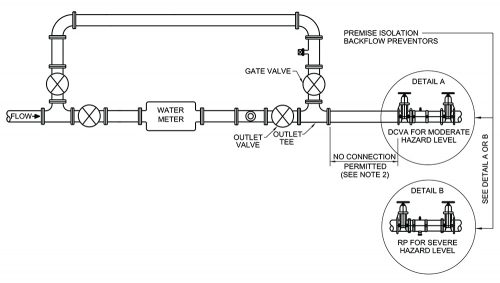
As a certified Cross Connection Control Specialist, you can now complete and submit Backflow Prevention Device Test Reports online. Once you submit your test report, you and your client will receive a confirmation by email, including your test result.
To help protect the safety of the City’s drinking water, it is mandatory under the City of Toronto’s Water Supply By-law for property owners of industrial, commercial, institutional and Part 3 residential properties (as defined by the Ontario Building Code), as well as construction sites, to install a backflow prevention device on the water supply line(s) to their facility. This is done to isolate buildings from the City’s water distribution system, helping to ensure contaminants do not enter drinking water.
A complete list of sectors required to install a device can be found in Schedule 5 of the Water Supply By-law.
Backflow is the undesired reversal of water flow against the normal direction. This can occur through back pressure or back siphonage.
There are two types of backflow prevention devices: Double Check Valve Assembly and Reduced Pressure Principle Assembly.
The type required in a building is based on the hazard level, which is listed by sector in Schedule 5 of the Water Supply By-law. Should you require assistance determining the correct device for your facility, please contact Toronto Water at 416-394-8888.
 Required for facilities classified as “moderate hazard.” It consists of two check valves, which help to provide protection in the event that one valve does not close tightly. As DCVA valves can fail with no visible warning, they must be tested at least once a year to ensure proper operation.
Required for facilities classified as “moderate hazard.” It consists of two check valves, which help to provide protection in the event that one valve does not close tightly. As DCVA valves can fail with no visible warning, they must be tested at least once a year to ensure proper operation.
 Required for facilities classified as “severe hazard.” It consists of two independently acting, internally loaded check valves, separated by a reduced pressure zone. RP devices must be installed in an area with adequate drainage and tested at least once a year.
Required for facilities classified as “severe hazard.” It consists of two independently acting, internally loaded check valves, separated by a reduced pressure zone. RP devices must be installed in an area with adequate drainage and tested at least once a year.
Backflow prevention devices must be installed by a plumber licensed with the City of Toronto. A list of qualified plumbers can be obtained by sending a request to backflow@toronto.ca. This list is for convenience only; the City of Toronto does not endorse or accept liability or responsibility for work completed by companies on the list. Property owners are encouraged to get several independent quotes before choosing a plumber.
A building permit is required for all new installations and replacements. Permits can be requested online or over the counter, and are typically obtained by the plumber on behalf of the property owner.
Devices should be installed immediately after the water meter and by-pass piping. This ensures that water from the private plumbing system will not flow back through the meter into the City’s water supply.
There must be no branch or hose connections between the water meter/by-pass and the backflow device. Thermal expansion must be addressed within the private plumbing system as per Part 7 of the Ontario Building Code.
RP devices cannot be installed below grade in a pit, chamber or vault. Discharges must be directed to a sanitary sewer.

Testing can be completed by plumbers, engineers and fire system sprinkler fitters certified as Cross Connection Control Specialists. See Schedule 6 of the Water Supply Bylaw for a full list of criteria for testers. Please review this carefully before registering. Do not test until your profile has been created with the Backflow Program.
If you believe you meet the criteria listed in Schedule 6 of the Bylaw and would like to register with the Backflow Program, please email PDF copies of the following documents to backflow@toronto.ca.
For Plumbing Contractors:
1.) A valid copy of the City of Toronto plumbing contractor business licence (current within 1 year from the date of issuance). To find information on how to obtain a valid licence, please visit permits & licences.
2.) A valid copy of the Master Plumber, or Journeyman Plumber, or Apprentice Plumber, or Industrial Millwright (limited to test BFPs on the domestic and fire line supply only) Certificate of Qualification from the College of Trades;
3.) A valid copy of the Cross Connection Control Specialist certification with either the OWWA (current within five year from the date of issuance), or ASSE certification (current within three years from the date of issuance)
4.) A valid calibration certificate (current within one year from the date of issuance) for the test gauge owned by the company
5,) A valid company phone number
6.) An email address for correspondences.
For Fire Sprinkler Company:
1.) A valid copy of the Fire System Sprinkler Fitter Certificate of Qualification from the College of Trades
2.) A valid copy of the Cross Connection Control Specialist certification with either the OWWA (current within five year from the date of issuance), or ASSE certification (current within three years from the date of issuance)
3.) A valid calibration certificate (current within one year from the date of issuance) for the test gauge used by the company
4.) Company information, including name and mailing address
5.) A valid company phone number
6.) An email address for correspondences.
For a Professional Engineer, or a Certified Engineering Technologist:
1.) For a Professional Engineer: documentation that demonstrate that you are in good standing with the Professional Engineers of Ontario
For a Certified Engineering Technologist (NOTE: Required to be under the direction of a Professional Engineer): documentation that demonstrates that your certification with the Ontario Association of Certified Engineering Technicians and Technologists is in good standing. Can only test and carry out cross-connection/backflow prevention surveys on domestic supply and fire protection systems.
2.) A valid copy of the Cross Connection Control Specialist certification with either the OWWA (current within five year from the date of issuance), or ASSE certification (current within three years from the date of issuance)
3.) A valid calibration certificate (current within one year from the date of issuance) for the test gauge used by the company
4.) Company information, including name and mailing address
5.) A valid company phone number
6.) An email address for correspondences.